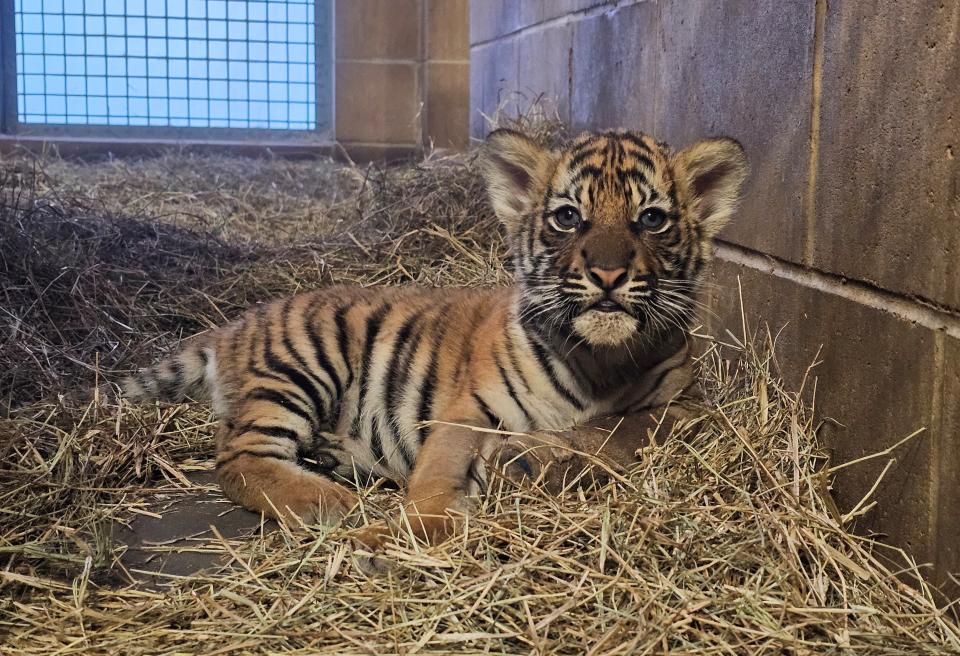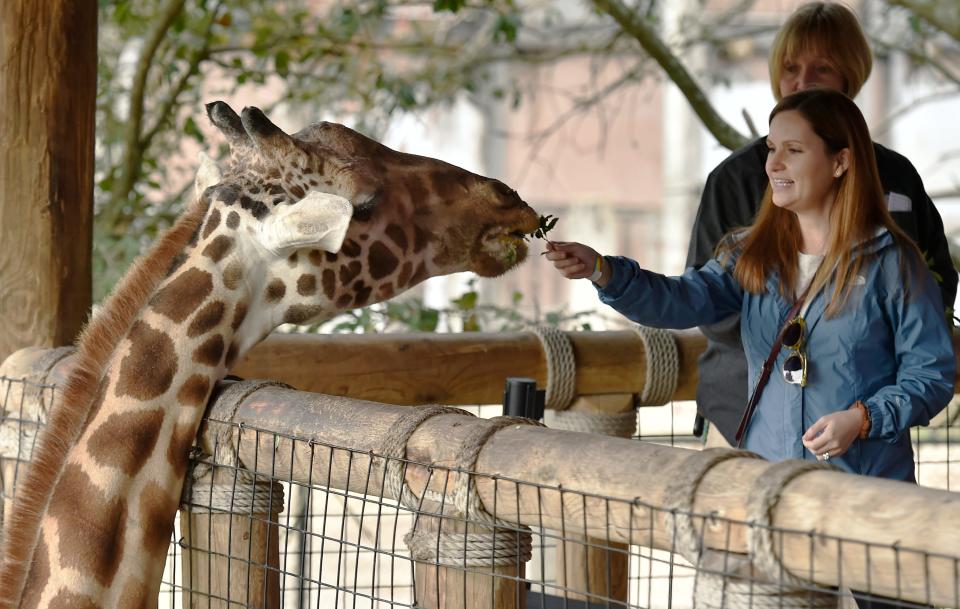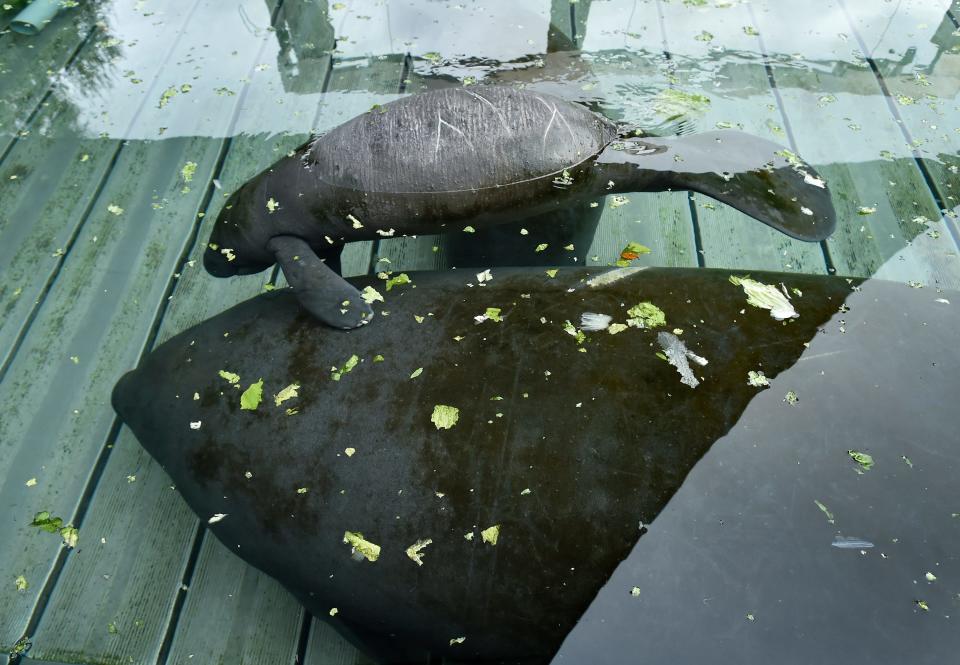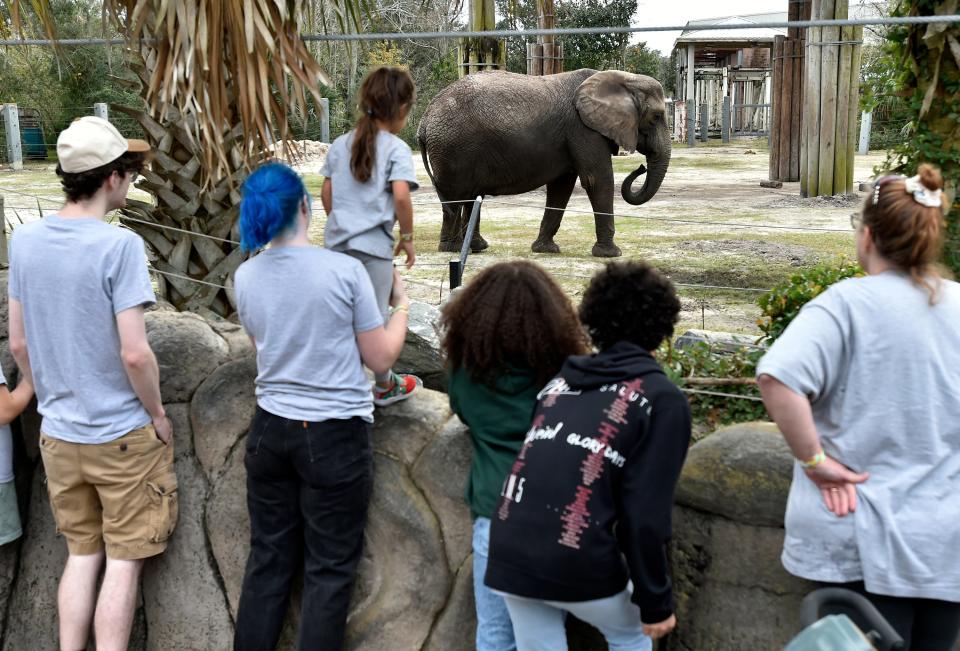Jacksonville Zoo on a mission: conservation of wildlife and wild places at home and abroad
The birth of three critically endangered Malayan tiger cubs at the Jacksonville Zoo and Gardens underscores the nonprofit institution's crucial but lesser-known role in global, national and state conservation efforts to save animals considered at risk of potential extinction.
Recently named Mina, Machli and Beppy, the cubs are the latest species survival success story at the zoo in North Jacksonville that's home to more than 1,500 exotic and rare animals along with 1,000 plant species.
Approximately 38 percent of the zoo's animal species are designated as critically endangered, endangered, threatened or vulnerable in the wild by the International Union for Conservation of Nature (IUCN) as well as U.S. Fish and Wildlife Service (USFWS) or Florida Fish and Wildlife Conservation Commission (FWC).
"We are a conservation organization. We're here to make a difference in the world and to help ensure that future generations can experience wildlife and wild places," Jeff Ettling, president and CEO of Jacksonville Zoo and Gardens, told the Times-Union.
The Jacksonville Zoo is among 239 accredited members of the Association of Zoos and Aquariums (AZA), which sets standards for animal welfare and facility operations as well as oversees multiple species conservation/survival programs.
The bottom line: the Jacksonville Zoo — an AZA-accredited member since 1987 — is more than an entertaining place to spend an afternoon looking at animals.
"When people come and spend a day with us they are helping to make a difference in the world for wildlife and wild places," Ettling said.
Species survival plan

The Jacksonville Zoo participates in AZA's Species Survival Plan (SSP) as well as its Saving Animals from Extinction (SAFE) programs. Those programs involve working with other AZA-accredited zoos to focus on preserving the population of endangered and threatened species by using genetics, husbandry, demographics, and other scientific data.
"So between SAFE and SSP, we create an opportunity, No. 1 to maintain viability in our populations, which is probably our first opportunity to make a connection with guests. And through those connections and opportunities for them to make a difference in the world around us," said David Hagan, chief zoological officer for the Jacksonville Zoo.
It's about making a positive change for the planet as a whole, not just animals, he said.
"We're all interconnected. We can't survive unless the animals survive and the plants collectively. So, we all have to find a way to co-exist," Hagan said.
Animal ambassadors

Ettling said the SSP programs focus on the breeding of animals with different genetic lines to help stabilize species populations. Genetic material is exchanged between the parent animals — generally living at separate AZA zoos. But sometimes the potential parents live at the same zoo.
The three Malayan tiger cubs — two girls and a boy born Nov. 5 — and their parents, Cinta and Bashir, are the most recent Jacksonville Zoo species survival success stories.
The tiger family is among a combined total of 76 species in the zoo's SSP program. That program lists 43 as "signature species," while 33, including the Malayan tigers, are among 33 listed as "provisional species."
Born in April 2023, Banks was the first jaguar cub born at the Jacksonville Zoo in a decade. His parents, Babette and Harry, also live at the zoo but not together. Jaguars listed as a near-threatened species by IUCN are among 10 species in the zoo's SAFE program.
Other successes include two Eastern Bongo calves born last year. Designated by the IUCN as critically endangered, the Eastern bongos are among the signature SSP species at the zoo.
Animals some might consider less than cute — such as the Puerto Rican crested toad — also are a focus of the Jacksonville Zoo's species survival efforts. In May, the zoo repatriated 8,272 of the small amphibians back to Puerto Rico.
That was the largest group of Puerto Rican crested toads raised and released by the zoo. Its second-highest release was 3,720, but on average, the zoo typically releases about 1,000 annually.
Manatees a priority

Nursing critically sick and injured manatees back to health to be returned to the wild also is a Jacksonville Zoo priority. The zoo has released 35 since opening its Manatee Critical Care Center in 2017.
Manatees are designated a threatened species. Multiple conservation organizations are pressing the U.S. Fish and Wildlife Service to list the iconic gentle marine animals as endangered.
Boat strikes, starvation and cold stress are the leading causes of Florida manatee deaths. A total of 556 manatees died last year, preliminary FWC data show.
The Jacksonville Zoo's Manatee Critical Care Center is one of only three such institutions in Florida. It's also the smallest but is expanding.
Manatees will be the first animals that zoo visitors see after they walk through a new 50-foot-high entranceway when an ongoing $70 million expansion project is completed in 2025.
J. Wayne and Delores Barr Weaver, former owners of the Jacksonville Jaguars, donated $3 million for the new Manatee River exhibit that will expand significantly the existing Manatee Critical Care Center.
Craig Miller, curator of mammals, said currently they can handle five or six manatees, depending on their condition, at the care center. The zoo also has its own Marine Mammal Rescue Team that aids FWC personnel rescue injured and sick manatees.
"We'll be able to handle at least 15 in the new facility along with the current facility so we'll be looking at about 20 animals potentially," Miller said. "I think if you build it they will come. Unfortunately, even if the manatee population increases, that is just more animals that will get injured or sick."
Ettling said the new Manatee River exhibit "will be front and center," exemplifying the zoo's emphasis on conservation.
Conservation partners worldwide

Ettling said $1 from every single zoo admission and about $4 from every membership helps support the animals.
Jacksonville Zoo has a conservation strategic plan — an AZA requirement — which is regularly updated, said John Lukas, curator of wildlife conservation. Lukas and his staff work with about 40 conservation partners at home and abroad.
The plan has three components: global biodiversity, local/regional projects and a staff-driven program connecting zoo personnel with field projects, he said.
The zoo is a longtime partner with the University of Florida to support the conservation work of Rupununi Wildlife Research Unit in Guyana regarding jaguars, giant otters, giant anteaters and giant armadillos.
The zoo also works with Elephants for Africa — a Botswana-registered non-government organization focused on the conservation of African Savannah Elephants in Botswana.
In addition, the zoo supports the work of Lola ya Bonobo, which is the only bonobo sanctuary in the Democratic Republic of Congo.
Here at home, the zoo works with the U.S. Fish and Wildlife Service as well as the Florida Fish and Wildlife Conservation Commission regarding manatees and other wildlife.
Education key to species survival
The Malayan tiger cubs as well as other rare and exotic species at the zoo have a story to tell and lessons to teach as "ambassadors for the wild species," zoo officials said.
The zoo shares those stories via a variety of educational programs.
The zoo, Ettling said, is "kind of the last vestige of nature for a lot of kids." Pro-environmental behavior is formed at an early age so zoos and aquariums play a pivotal role in introducing kids to nature, he said.
Leading the zoo's education initiatives is free admission to every student in Duval County. Its Zoo Teens and Junior Volunteers programs also offer youth a chance to learn more about the animals and share that knowledge.
"Hopefully, they will go on to be good stewards of the planet as they get older," Ettling said.
For all ages, the zoo's Live Animal Cams — currently focused on the tiger cubs — introduces online viewers to the zoo's animals.
Exhibit honored: Jacksonville Zoo earns national recognition for Land of the Tiger exhibit
Rezoovenation boost: CSX donates $1 million to Jacksonville Zoo for new train station
And the Manatee River exhibit with the Manatee Critical Care Center is another showcase for the ongoing species survival efforts.
"… What we all envision, basically, is a world through our work where all people, respect, value and conserve wildlife and wild places," he said.
BY THE NUMBERS
The Jacksonville Zoo and Gardens is home to hundreds of animals designated as endangered, threatened or vulnerable species. The designations come from the International Union for Conservation of Nature (IUCN), U.S. Fish and Wildlife Services (USFWS) and Florida Fish and Wildlife Conservation Commission (FWC). Some species have multiple designations. By the numbers, here are those species.
13 species IUCN Critically Endangered Species including the Blue-Eyed Black Lemur, Eastern Bongo, Western Lowland Gorilla, Puerto Rican crested toad and Malayan tiger
23 species IUCN Endangered Species including the Florida manatee, African elephant, Giant otter and Komodo dragon
26 species IUCN Vulnerable Species including the Reticulated giraffe, African lion, Asian small-clawed otter and Giant anteater
12 species IUCN Near-threatened Species including the Southern white rhinoceros, jaguar, African straw-colored fruit bat, Marbled teal and Bluntnose Stingray
19 species USFWS Endangered Species including the Black-and-white ruffed lemur, Giant otter, Malayan tiger, bonobo and Cotton-top tamarin
11 species USFWS Threatened Species including the African elephant, Puerto Rican crested toad, Florida manatee, Eastern indigo snake and Grevy's zebra
3 species FWC Threatened Species including the Florida manatee, Eastern indigo snake and Gopher tortoise
This article originally appeared on Florida Times-Union: Jacksonville Zoo working to save wildlife, wild places worldwide

